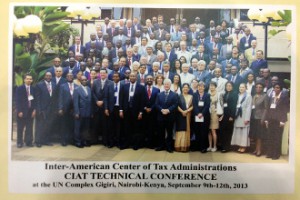Memories of Africa
Comments on the Nairobi technical conference
 At the 2013 Technical Conference I had the opportunity to comment on the presentations on tax audits in the digital era made at the inaugural session by Jaco Tempel, from the Tax and Customs Administration of The Netherlands and Enrique Sánchez-Blanco from the Spanish State Agency of Tax Administration.
At the 2013 Technical Conference I had the opportunity to comment on the presentations on tax audits in the digital era made at the inaugural session by Jaco Tempel, from the Tax and Customs Administration of The Netherlands and Enrique Sánchez-Blanco from the Spanish State Agency of Tax Administration.
Both papers which may be consulted in Spanish and English at the conference site, illustrate the challenges, and especially, the opportunities afforded by the current level of digital development in control issues. The two presentations highlight the ever more important use of technology in the tax administration.
I wanted to point out some elements which, in my opinion, deserve special attention from our countries, not necessarily to copy them, but rather as successful practices which may serve as basis for their own solutions.
They include aspects worth knowing, such as: the incorporation of technology for improving taxpayer relationships, with tools ranging from registration in the electronic file; the use of electronic means for obtaining third party information; the need for implementing mechanisms for structuring the large volumes of information, including business intelligence and data mining elements for risk management and audits per se, either through the use of self-developed tools or those available in the market; the security mechanisms implemented in the processes for obtaining taxpayer data via electronic means, to avoid damages or interruptions in the taxpayer’s operation, as well as to ensure the non-alteration of data delivered and obtained through the application of signature algorithms and the four or six-eye policy.
Both colleagues coincided in stating that auditors currently require knowledge and skills whereby they may take advantage of the information and tools available for their audits. Many procedures and practices which traditionally involved a large manual workload have been replaced with automated processes that identify inconsistencies and provide clues, thereby affording auditors more interesting opportunities, who, in order to apply them require competencies that were not essential twenty years ago and which, perhaps, not all acquired them. At times, there is a need for assistance and thus, in the Netherlands there are information technology auditors, specialized in auditing as well as technology. Perhaps we could ask ourselves, as Socorro Velázquez, our Planning and Institutional Development Director did, whether there is a lag between those capabilities of all our auditors and the technological developments they have available.
One aspect worth noting is the definition of the FILE—TAX, accounting audit file, used in the Netherlands for reporting accounting elements. The proposal is much more than a data standard. The initiative states that accounting software manufacturers must include the mechanism for directly producing those files. As stated by Flavio Araujo, from the Secretariat of Federal Revenues of Brazil, it is a very different option from the one adopted by Brazil with the SPED system, which leaves to the taxpayers the responsibility of producing the files that comply with the standard. Rather, they receive a free tool provided by the Administration to validate their files against the standard.
One of the most interesting topics raised by both lecturers was the use of the Web for detecting operations or clues of operations that may possibly respond to evading behaviors. Both administrations have their own Internet “searchers” for identifying transactions in Internet that may interest the tax administration.
Nevertheless, technological developments not only afford opportunities. Technology may also be used for attempting to reduce tax payments. It also deals, for example, with techniques for counteracting the use of “phantomware” which seeks to reduce point-of-sale cash transactions or the anecdotal experience shared by Enrique regarding data concealed in erotic pictures found in a taxpayer’s machine and the peculiar way of displaying them. Regards and good luck.
1,022 total views, 2 views today
